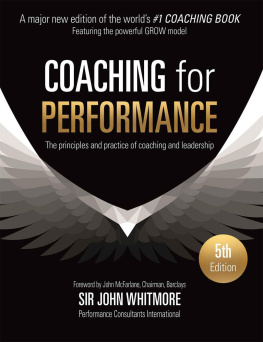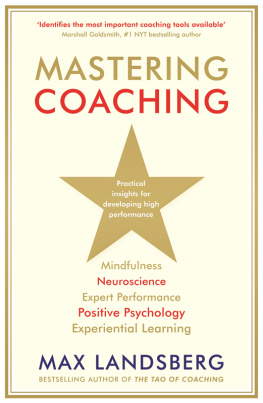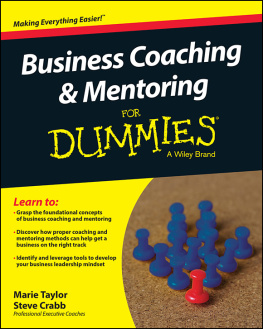
WILEY-VCH Verlag GmbH & Co. KGaA
All books published by Wiley-VCH are carefully produced. Nevertheless, authors, editors, and publisher do not warrant the information contained in these books, including this book, to be free of errors. Readers are advised to keep in mind that statements, data, illustrations, procedural details or other items may inadvertently be inaccurate.
2018 Wiley-VCH Verlag & Co. KGaA, Boschstr. 12, 69469 Weinheim, Germany
All rights reserved (including those of translation into other languages). No part of this book may be reproduced in any form by photoprinting, microfilm, or any other means nor transmitted or translated into a machine language without written permission from the publishers. Registered names, trademarks, etc. used in this book, even when not specifically marked as such, are not to be considered unprotected by law.
Library of Congress Card No.:
applied for
British Library Cataloguing-in-Publication Data
A catalogue record for this book is available from the British Library.
English version by Jutta Scherer and Ann-Terry Gilman
(Munich and Duesseldorf, Germany)
Figures were created by visual solutions, Mag. Christoph J. Tamussino und Lwenherz, Mag. Martina Grser.
Bibliographic information published by the Deutsche Nationalbibliothek
The Deutsche Nationalbibliothek lists this publication in the Deutsche Nationalbibliografie; detailed bibliographic data are available on the Internet at .
Cover: Torge Stoffers, Leipzig
Coverfoto: tiero - stock.adobe.com
Satz: Lumina Datamatics
Print ISBN: 978-3-527-50966-9
ePub ISBN: 978-3-527-82205-8
Foreword
Coaching is a live issue for many organisations. A significant number amongst those would lay claim to a coaching culture. Despite this profession of a developmentally focused organisation with managers who spend time building the capability and competence of their people, few have the kind of clarity to develop coaching behaviours amongst those who manage people.
One of the challenges is to ensure that there is a common understanding and language around what the expected activity might be and shared expectations about the role of those who lead teams of people. Ask nine managers in an organisation with a clear commitment to a coaching culture and you may find ten different definitions of what coaching is and what it is not!
The focus of Masha Ibeschitzs book is to tell stories. Stories which illuminate and resonate. Stories which describe the over-operationally involved role of many modern managers. Stories which shed light on those difficult or unsatisfactory conversations when despite the best intentions problems remain and unhelpful behaviours are unchanged. She also shows how those conversations can succeed, by using pragmatic coaching tools.
Mashas approach is to be extremely clear about what coaching is and perhaps most importantly what it isnt. If nothing else, those who read this book will come away with clear definitions. Through her storytelling, she illuminates the issues which can hinder as well as the tools which can promote effective coaching conversations. Each chapter ends with a brief list of key takeaways; bullet point summaries which inform of changed practice.
Not every organisation is structured to facilitate the kind of coaching exchange which Masha advocates yet. It would be great if sometimes leaders were enabled and given the time to lead. Perhaps the greatest contribution Impact can make is on those in the upper echelons of organisations who blithely talk about team leaders coaching their people while erecting insuperable barriers to them ever being able to fulfil this portion of their role. Through an appreciation of the possibilities of implementing effective coaching and choosing tools wisely, it is devoutly to be hoped that management can move from being a status to being an activity an activity focused on enabling people to give of their best and enhance the organisations success.
Robin Hoyle, FLPI
Introduction
Why managers should also be development guides
Does your work diary look like a big, colorful patchwork rug? Does checking your emails feel like someone has opened the floodgates? Are you wondering whether you will ever find the time you need to devote to your strategic work? This book is for you.
In the following chapters, I will show you how you can use certain coaching techniques to develop your people so they can support you more effectively and you can work jointly towards your companys success. Developing your people to a sufficient level is essential for you to be able to rely on them fully. Key tasks can and should be delegated only to truly capable and engaged people I assume you agree. Employees who havent been developed to the level required can turn into nuisances. Theyll take up much of your time and attention by keeping you tied down with everyday chores. Tasks you delegated will come boomeranging back. In the end, youll face destructive stress patterns, preventing you and your organization from enjoying the fruits of your work.
It doesnt have to be like this.
Once you master a few basic skills of coaching, youll take a crucial step: from being a manager to being a leader and development guide for your people. Youll be able to give them exactly the impetus they need for their development and which fits their current situation. Both sides will benefit, and so will the overall system and thus your company. Everyday business offers countless opportunities to use coaching techniques productively. These include situations that might not call for coaching at first: You want to ensure that a creative brainstorming session produces good results? There are techniques for that. Resolve a conflict between two wranglers? Not a big challenge for someone who has mastered coaching techniques. Once youve started using the tools in the big and colorful coaching toolbox, youll know how to give the right kind of impetus for each and every situation in your role as a development guide.
I have long been mulling over the idea of providing managers with a kind of vade-mecum, a quick and easy guide to learning the basics of coaching. Now Ive finally found the necessary inspiration and patience and the right professional support to make it happen. This book is not intended as a replacement for any of the training programs for coaches, or for any of the specialized coaching literature. Experience has taught me, however, that getting the full training as a coach is usually out of the question for many managers, due to time restraints or at least they wont be able to make it any time soon. This book will provide everyone who leads people on a daily basis with a best of coaching collection, for immediate use in your daily management practice.
In writing this book, I have drawn on over 20 years of coaching experience, which Ive gathered in the international business environment and with companies of virtually all sizes and in a wide array of industries as both a coach and a coachee. Be assured that Ive personally experienced each of the situations described here from a 360 perspective. You can also be sure that none of these situations took place exactly as described. If, for instance, you read about a male CEO of a large Italian-based furniture company, theres a 50% chance that this person really was a man. It may have been a woman. And you can be fairly certain the individual was neither Italian nor in the furniture industry. In other words, I have taken great care to choose real events and disguise them thoroughly by shifting them to other locations and industries, changing the backdrops such as hotels or convention centers, and, of course, giving everyone fantasy names. I did place my stories mostly in Europe, which does not mean they may not have happened elsewhere. As a world citizen with an Austrian passport, Ive taken the liberty to immortalize my home country, so to speak, by making it the occasional venue of a story. There may not be much to be said for it, but there is nothing to be said against it, either right?










